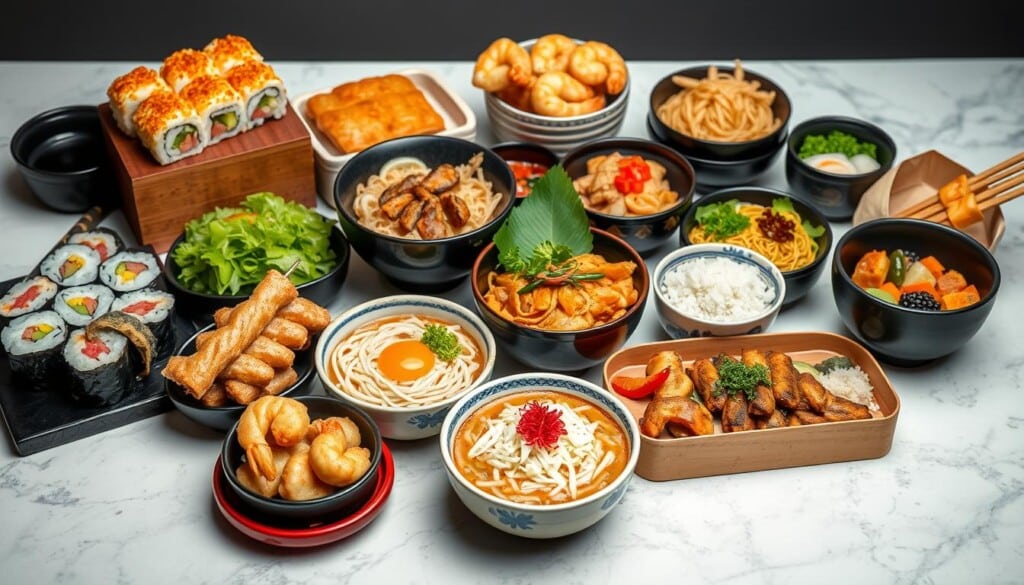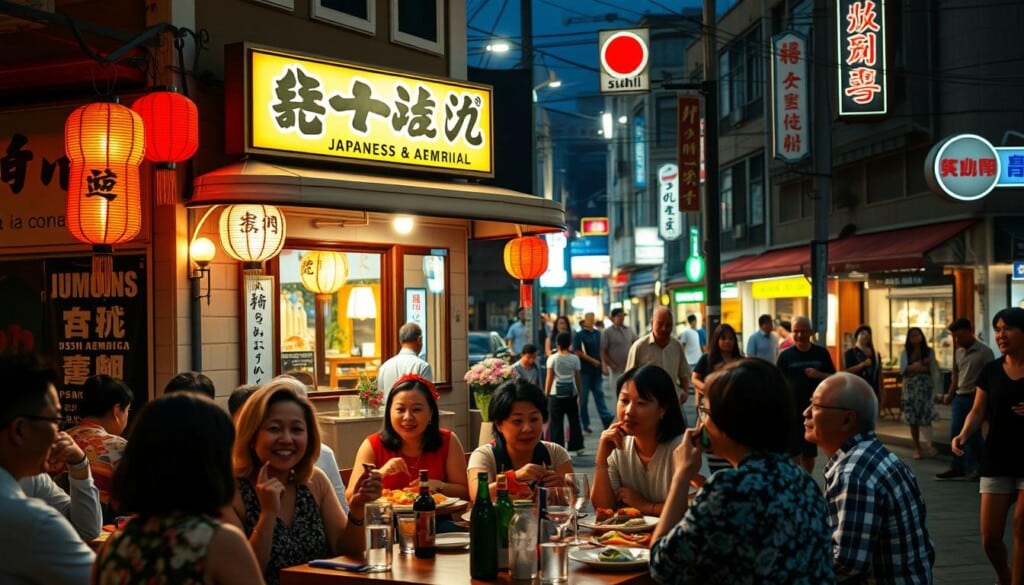Have you ever thought about how sushi became a big part of American food? Japanese food places in the US offer a wide range of real Japanese dishes. They change how we see food, introducing us to new tastes and experiences.
Top sushi spots are now everywhere, bringing more than just sushi. They offer unique izakaya experiences and creative dishes that mix Japanese flavors with others. This journey into Japanese food invites you to find great options near you.
Key Takeaways
- Japanese food restaurants offer a diverse range of dishes that cater to various tastes.
- Sushi has become a staple in American cuisine, reflecting its popularity and accessibility.
- Izakaya dining provides a unique social experience centered around shared plates.
- Fusion cuisine combines traditional Japanese elements with other culinary styles.
- Exploring local Japanese restaurants enhances cultural appreciation and culinary diversity.
Introduction to Japanese Cuisine
Japanese cuisine is known for its rich flavors and fresh ingredients. It focuses on simplicity and balance. Seasonal ingredients add unique tastes to traditional dishes.
Rice, seafood, and vegetables are key in many meals. Techniques like fermentation and grilling bring out the best in these ingredients. This makes every meal special.
Unique Flavors and Ingredients
Japanese dishes get their special flavors from chosen ingredients and cooking methods. Umami-rich elements like kombu and miso add depth. Seasonal vegetables are often presented beautifully, showing respect for nature.
The balance in these dishes shows careful preparation. It highlights the importance of each ingredient in the meal.
Cultural Significance of Japanese Food
In Japan, food is more than just food. It’s a way to connect with family and tradition. Meals are rituals that honor the seasons and the producers.
Preparing Japanese food connects people to their heritage. It also strengthens community bonds through shared meals and traditions.
Why Choose Japanese Food Restaurants?
Japanese food is known for its unique flavors and health benefits. It’s a favorite for those wanting to improve their dining experience. The health perks of Japanese cuisine come from its focus on fresh, seasonal ingredients.
These ingredients ensure a balanced diet. Japanese dishes are often low in fat but high in omega-3s. They also include lots of vegetables, fish, and whole grains for a nutritious meal.
Health Benefits of Japanese Cuisine
The nutritional value of Japanese food is a big reason for its popularity. It’s made with fresh, unprocessed foods that are low in calories but full of nutrients. Fish, rich in omega-3s, is good for the heart and brain.
Fermented foods like miso and pickled vegetables are also part of the diet. They help with gut health. Eating Japanese food is not just about filling your stomach; it’s about nourishing your body.
The Dining Experience
Japanese food restaurants offer a special dining experience. They focus on the beauty of the food and the culture behind it. Diners enjoy a meal that’s not just about eating, but about sharing and connecting.
The use of seasonal ingredients adds to the experience. Each dish is a reflection of nature’s bounty. Enjoying Japanese food is like experiencing a piece of art, making every meal a memorable event.
Popular Japanese Dishes to Try
Exploring Japanese food reveals a world of flavors and textures. You’ll find everything from sushi to noodle dishes. Each dish caters to different tastes, making dining at a Japanese restaurant a unique experience.
Sushi Varieties
Sushi is a key part of Japanese cuisine, with many ingredients and styles. You’ll find nigiri, with fish on rice, and sashimi, which is just raw fish. Specialty rolls, or maki, mix different toppings and fillings.
This dish is a must-try for anyone wanting to taste Japan’s culinary art.
Ramen and Noodle Dishes
The best ramen in town is a comforting treat. Each bowl has its own flavors and ingredients. You can try tonkotsu, miso, or shoyu ramen, each with its own unique taste.
Other noodle dishes like udon and soba are also great. They show off Japanese culinary traditions.
Tempura and Other Classics
Tempura is a classic dish, with lightly battered and fried veggies or seafood. It keeps the natural flavors while adding a crispy texture. Teriyaki and donburi are also classics you can find in many restaurants.

The Growth of Japanese Food Restaurants in the US
Japanese food restaurants are becoming more popular in the US. This shows that American diners are trying new things. These restaurants now offer a wide range of dishes from different regions.
They mix old cooking methods with new ideas. This makes Japanese food exciting and fresh.
Trends in Japanese Cuisine
Izakaya-style dining is becoming popular. It’s casual and fun, with everyone sharing small dishes. This makes eating out more interactive.
Using seasonal ingredients is another trend. It makes food taste better and supports local farmers. People also want to try sushi with unique ingredients for a special experience.
Regional Variations Across the States
Japanese food restaurants vary by region. In Los Angeles, you can find traditional ramen. New York offers fancy sushi with a focus on skill and presentation.
This variety shows how Japanese food fits into local tastes. It adds richness to American food culture.
How to Find the Best Local Japanese Restaurants
Finding the best local Japanese restaurants can really improve your dining experience. With Japanese cuisine becoming more popular in the U.S., picking the right place can be tough. Using special resources can help you find great places to eat and make smart choices.
Utilizing LocalZ for Restaurant Discovery
LocalZ is a great tool for finding local Japanese restaurants. It’s an online directory that connects you with top Japanese spots. You can search by cuisine, dishes, or ratings, making it easy to find what you want.
By using LocalZ, you can choose based on your preferences and location. This ensures you pick the best options available.
Customer Reviews and Ratings
Customer reviews are key when choosing where to eat. Feedback from others can tell you a lot about a restaurant’s quality and experience. Reading reviews helps you see what dishes are popular and what services are offered.
Using this information can make your dining experience better. You can check the atmosphere, service, and food quality before you go. For detailed reviews and insights, check out LocalZ.
Exploring Top Japanese Food Restaurants
Japanese food restaurants offer a wide range of culinary experiences in major cities. New York City, Los Angeles, and Chicago are home to both famous spots and hidden gems. Let’s take a closer look at each city’s top Japanese food places.
Best in New York City
New York City is known for its top sushi restaurants. These places offer an unmatched dining experience. They serve sushi and authentic dishes made with care.
Diners can enjoy the best Japanese food in NYC at spots like Sushi Nakazawa and Yasuda. These restaurants are famous for their fresh ingredients and skilled chefs.
Must-Try Options in Los Angeles
Los Angeles has a wide variety of Japanese food restaurants. Places like Nobu and Katsuya offer modern Japanese dining with great flavors. They mix classic recipes with new techniques, making them a must-visit for food enthusiasts.
Hidden Gems in Chicago
Chicago’s dining scene has many hidden gems serving Japanese cuisine. For a real taste of Japan, try restaurants like Katsu and Arami. They offer unique dishes and a welcoming atmosphere.
These lesser-known spots stand out among Chicago’s growing list of Japanese food restaurants.

Experiences Beyond Dining
Learning about Japanese culture is more than just eating. Activities like sushi-making classes and Japanese tea ceremonies give deeper insights. These experiences let you connect with the art and rituals of Japanese food.
Sushi-Making Classes
Sushi-making classes dive into the detailed techniques of making sushi. With expert chefs, you learn about choosing fresh ingredients and preparing rice. You also learn how to roll sushi. This hands-on learning makes sushi more than a meal; it’s a culinary art.
Japanese Tea Ceremonies
Japanese tea ceremonies are elegant rituals that show how to make and serve matcha. They blend beauty, etiquette, and mindfulness. Taking part in these ceremonies helps you understand Japanese hospitality and the value of simplicity and grace.
Special Dietary Options in Japanese Cuisine
Japanese cuisine has many special dietary options. It caters to different tastes and health needs. Fresh seasonal ingredients make vegetarian and vegan dishes taste great.
Many Japanese restaurants focus on vegetables, tofu, and rice. This makes them perfect for those who eat plant-based.
Vegetarian and Vegan Choices
Japanese restaurants have lots of vegetarian and vegan dishes. You can try vegetable tempura, soba noodles with sesame dressing, or tofu with soy sauce or miso. Sushi rolls with avocado, cucumber, or veggies are also available.
These options let you enjoy different flavors while sticking to your diet.
Gluten-Free Offerings
More people want gluten-free Japanese food, so restaurants have started to offer it. Soba noodles, made from buckwheat, are a great gluten-free choice. You can also have sushi without soy sauce or with gluten-free alternatives.
This makes it easy for those with gluten sensitivity to enjoy Japanese food without health issues.
Supporting Local Japanese Restaurants with LocalZ
In the United States, supporting local Japanese food restaurants is key. Platforms like LocalZ help find real dining experiences. They also help build stronger community ties.
This support boosts the local economy. It makes every patron’s choice more impactful.
Community Impact of Dining Locally
Dining at local Japanese restaurants helps neighborhoods thrive. It creates jobs and keeps local culture alive. Each dollar spent locally supports the community.
Promoting Local Businesses Through Listings
LocalZ highlights a range of Japanese food restaurants. This makes it simpler for people to support local businesses. As more listings appear, these places get more attention.
This helps them grow in tough markets. It’s a win-win for both restaurants and the communities they serve.

How LocalZ Enhances Your Dining Experience
LocalZ is a great tool for finding local Japanese food. It helps you discover restaurants that fit your taste. The platform makes it easy to find places you’ll love.
Easy Listings Search and Filtering
LocalZ’s interface is easy to use. You can search for restaurants by location, type of food, and more. This way, you can find the perfect spot for your meal.
Direct Booking Options
LocalZ also lets you book tables directly. This makes dining out more convenient. You can skip the wait and enjoy your meal without hassle.
Connecting with Local Businesses
Choosing to eat at local Japanese restaurants does more than just fill your belly. It helps build a stronger community. By supporting these places, you help the local economy grow. This supports everyone’s well-being and growth.
Engaging with Your Community
When you dine locally, you connect with unique flavors and cultures. You also help support local causes. By eating at places listed on LocalZ, you actively support these efforts.
Supporting Local Causes Through LocalZ
LocalZ makes it easy to find restaurants that care about the community. Many of these places work with local nonprofits. This way, every meal you have helps make your community better.
Conclusion
Starting a Japanese food adventure is a great way to dive into local cuisine. You get to enjoy the rich flavors and traditions of Japan. Whether it’s sushi in big cities or ramen in small towns, the dining experiences are endless and rewarding.
Every meal, whether in a famous restaurant or a hidden spot, adds to your culinary journey. It makes your trip even more special.
Making the Most of Your Japanese Food Adventure
To get the most out of your dining experience, try local foods. Joining classes and cultural events can help you understand Japanese customs better. This way, you’ll appreciate the cuisine even more.
LocalZ is a great place to find these unique experiences. It shows how important it is to support local businesses. They help grow the community.
The fun of a Japanese food adventure isn’t just the food. It’s also about the connections you make. By exploring local cuisine, you join a vibrant cultural exchange. It enriches both your taste and the community, making every meal a celebration.

